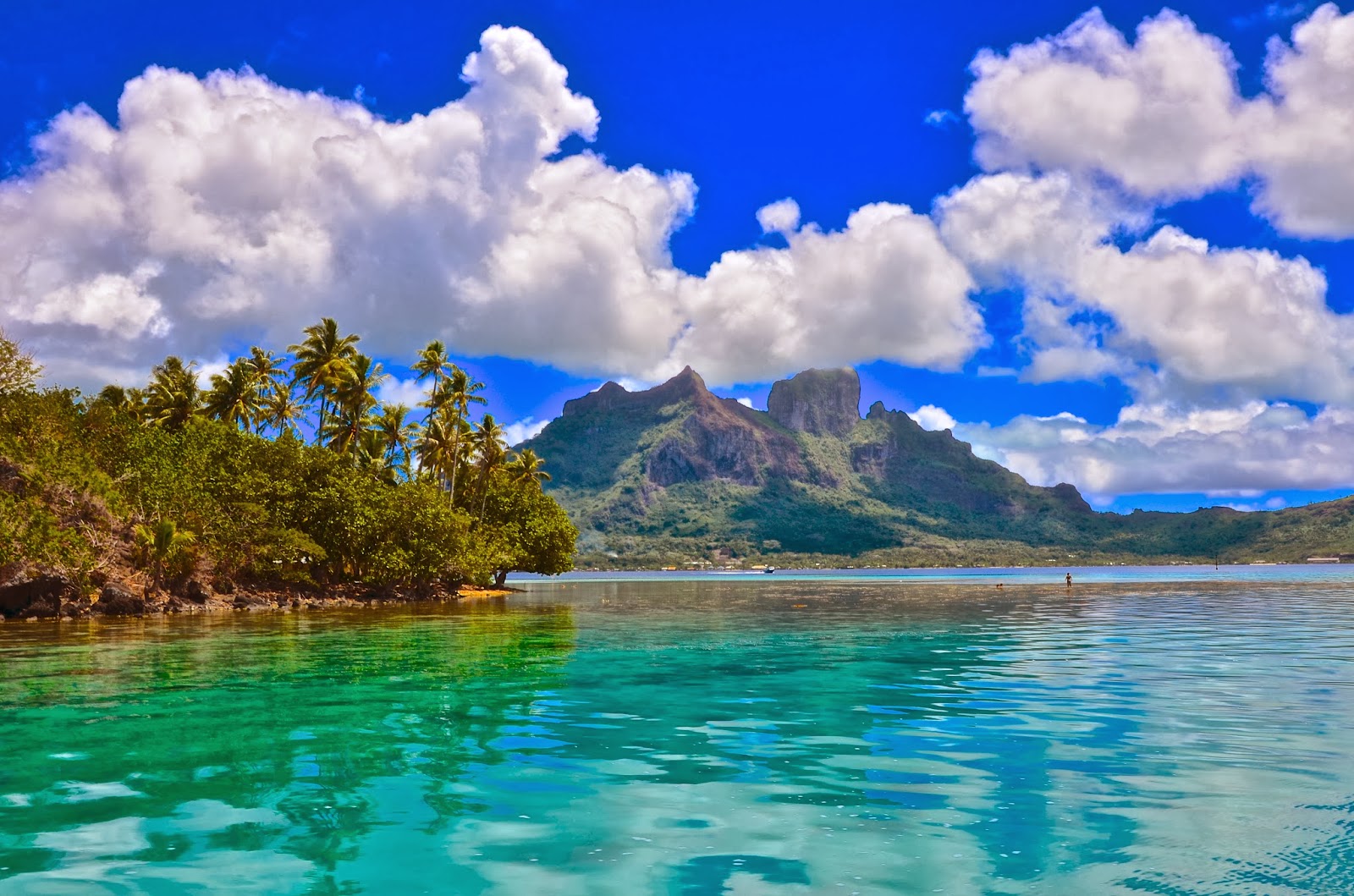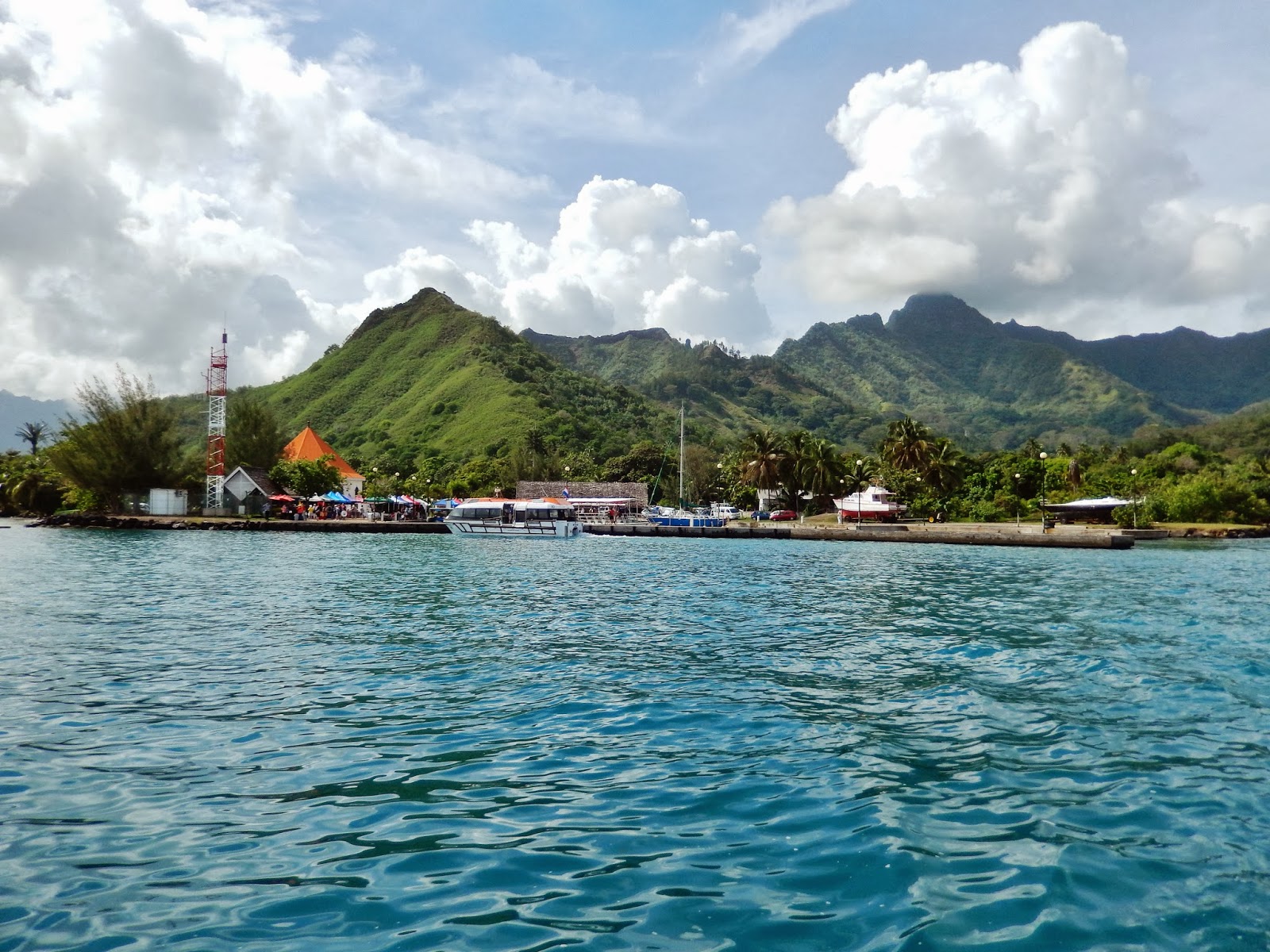We departed
Moorea about 5:00 PM on January 28th and sailed overnight to Bora
Bora—arriving the next day at about 8:00 AM. The distance from Moorea to Bora
Bora is about 165 miles, and this would be our third (and last!) island in the
Society Islands of French Polynesia. We were anchored off the town of
Vaitape—this would be a “tender port.”
The navigator Roogeveen was the first European to sight Bora Bora in
1722 and was followed by Captain James Cook in 1796.
Bora Bora is
a “barrier reef island”—described by Wikipedia as follows:
In 1842, Darwin explained the creation
of coral atolls in the southern Pacific
Ocean based upon observations made during a
five-year voyage aboard the HMS
Beagle from 1831 to 1836. Accepted as basically correct, his
explanation involved considering that several tropical island types—from high volcanic
island, through barrier reef island, to
atoll—represented a sequence of gradual subsidence of what started as an oceanic volcano. He reasoned that a fringing
coral reef surrounding a volcanic island in the
tropical sea will grow upwards as the island subsides (sinks), becoming an
"almost atoll", or barrier reef island, as typified by an island such
as Aitutaki in the Cook Islands, Bora
Bora and others in the Society
Islands. The fringing reef becomes a barrier
reef for the reason that the outer part of the reef maintains itself near sea
level through biotic growth, while the inner part of the reef falls behind,
becoming a lagoon because conditions are less favorable for the coral and
calcareous algae responsible for most reef growth. In time, subsidence
carries the old volcano below the ocean surface and the barrier reef remains.
At this point, the island has become an atoll.
It can be seen from a map and the description above that Bora Bora is a
“barrier reef island” or “almost atoll”—meaning that there is a large central
island of volcanic origin, surrounded by a lagoon, and outside the lagoon is a
circle of coral reefs and islands. The local name for an island in the outer reef
islands is “motu.”
Today, Bora Bora enjoys the reputation of being one of the most beautiful
and unspoiled islands in the South Pacific—a description with which we would
heartily agree!
Since we had just one day on Bora Bora and since the water, beaches, and
motu islands were the highlights, we decided to take the three hour Holland
America excursion titled “Motu Islet Lagoon Cruise and Beach Break.” So our day
started about 8:30 AM when we met with our tour group and took a tender ashore
to the town of Vaitape. After arriving on shore, we boarded the catamaran that
would take us out on our tour.
The catamaran first took us past Raititi Point, and then past Motu Toopua
and Motu Tapu. After a 45 minute trip (we had front seats on the catamaran, and
therefore a great view), we anchored and tied up just off the beach of a
private motu and waded ashore. There we were given about an hour and a half to
relax on the beach, go snorkeling, and explore the island. Bill choose to go
snorkeling right away—there was a nice little coral reef to explore—while Pat
enjoyed reading her book on a picnic table. But before long, Bill was able to
convince Pat to go into the water, which we did until a snack was served that consisted
of fruit, crackers, cakes and coconut, which was just perfect for that time of
day.
Soon after lunch, we re-boarded the catamaran and began our journey back to
Vaitape. Along the way, we anchored in a shallow section of the reef for
stingray feeding and black tip shark viewing—similar to what we did in Moorea.
And even though we had had a similar experience the day before, it was still
awe inspiring to hold a stingray that was almost as large as we were and observe
close up a school of sharks—each of which was 5 feet long or more!
After our shark/ray encounter, we hoisted anchor and continued on towards
Vaitape. Along the way we again saw the overwater, thatched roof bungalows that
are offered as hotel rooms—at great expense. This style of overwater hotel
rooms is common in all of French Polynesia—including Tahiti, Moorea, Bora Bora,
and New Caledonia.
Back in Vaitape, it was early afternoon and the last tender was not until
4:30 PM, so we had some time to explore on our own. Matira Beach—at the
southern end of the central island—was recommended to us, so we decided to go
down that way, and maybe get something to eat and do some swimming on the
beach.
Public transportation on Bora Bora—and other French Polynesian Islands—is
often via “Le Truck.” And as the name implies, these were trucks which had
benches placed in their pick-up bed for passengers to sit upon. It was a little
difficult, but into “Le Truck” we climbed and soon we were on our way to Matira
Beach.
During the 20 minute drive to the beach, we passed “Bloody Mary’s”—a very
famous restaurant and pub on Povai Bay. But we didn’t stop—we were traveling
independently and had to be careful about our time. (If we missed the last
tender, we would be on our own to get to our next port of call!) When we
arrived at Matira Beach, it was HOT!!!! We went down and onto the beach,
but soon were looking for a watering hole out of the sun. Fortunately we
quickly found a place which was right on the beach with a beautiful view. We
ordered lunch and more than one can of the local beer (who’s counting?) and
soon were joined by our friends Gaston and Carol Lacroix. Gaston and Carol are
French Canadians (Fortunately for us they speak good English!) and also
passengers on the Amsterdam who just happened to come into the same restaurant
at the time we were there. And so we enjoyed lunch and more than one beer
together. And this has happened to us so many times—we go off exploring on our
own, and then by chance run into friends who are like minded. Call it
serendipity!
Bill took a quick swim from the beach, but by about 3:30, it was time to
head back to Vaitape via “Le Truck” to catch a tender back to the Amsterdam. We
arrived in Vaitape before 4:00 PM, and discovered that there was a Chinese grocery
store near the port, and we hoped to get several cartons of fruit juice to take
back with us. Fruit juice and rum drinks are the perfect beverage for hot days
in French Polynesia! So after purchasing about 10 cartons of fruit juice (we
already had rum on board!), we caught one of the last tenders back, and soon
were onboard the Amsterdam enjoying the sail-away party.
We left Bora Bora about 5:30 PM, and our ship continued in a westward
direction. We would have Thursday, January 30th and Friday January
31st as very welcome “sea days” after 3 wonderful but very intense
days on three different islands of the Society Islands. Our next port of call
would be Pago Pago, American Samoa on Saturday, February 1st.














.jpg)













.jpg)


.jpg)

















